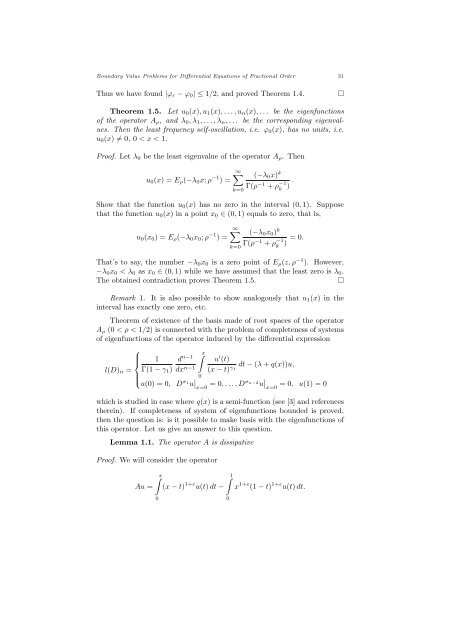FOR DIFFERENTIAL EQUATIONS OF FRACTIONAL ORDER
FOR DIFFERENTIAL EQUATIONS OF FRACTIONAL ORDER
FOR DIFFERENTIAL EQUATIONS OF FRACTIONAL ORDER
You also want an ePaper? Increase the reach of your titles
YUMPU automatically turns print PDFs into web optimized ePapers that Google loves.
Boundary Value Problems for Differential Equations of Fractional Order 31Thus we have found |ϕ ε − ϕ 0 | ≤ 1/2, and proved Theorem 1.4.□Theorem 1.5. Let u 0 (x), u 1 (x), . . . , u n (x), . . . be the eigenfunctionsof the operator A ρ , and λ 0 , λ 1 , . . . , λ n , . . . be the corresponding eigenvalues.Then the least frequency self-oscillation, i.e. ϕ 0 (x), has no units, i.e.u 0 (x) ≠ 0, 0 < x < 1.Proof. Let λ 0 be the least eigenvalue of the operator A ρ . Thenu 0 (x) = E ρ (−λ 0 x; ρ −1 ) =∞∑k=0(−λ 0 x) kΓ(ρ −1 + ρ −1k ) .Show that the function u 0 (x) has no zero in the interval (0, 1). Supposethat the function u 0 (x) in a point x 0 ∈ (0, 1) equals to zero, that is,u 0 (x 0 ) = E ρ (−λ 0 x 0 ; ρ −1 ) =∞∑k=0(−λ 0 x 0 ) kΓ(ρ −1 + ρ −1k ) = 0.That’s to say, the number −λ 0 x 0 is a zero point of E ρ (z, ρ −1 ). However,−λ 0 x 0 < λ 0 as x 0 ∈ (0, 1) while we have assumed that the least zero is λ 0 .The obtained contradiction proves Theorem 1.5.□Remark 1. It is also possible to show analogously that u 1 (x) in theinterval has exactly one zero, etc.Theorem of existence of the basis made of root spaces of the operatorA ρ (0 < ρ < 1/2) is connected with the problem of completeness of systemsof eigenfunctions of the operator induced by the differential expression⎧⎪⎨ 1 d n−1 ∫xu ′ (t)l(D) n = Γ(1 − γ 1 ) dx n−1dt − (λ + q(x))u,γ1(x − t)0⎪⎩u(0) = 0, D σ 1u ∣ x=0= 0, . . . , D σ n−2u ∣ x=0= 0, u(1) = 0which is studied in case where q(x) is a semi-function (see [3] and referencestherein). If completeness of system of eigenfunctions bounded is proved,then the question is: is it possible to make basis with the eigenfunctions ofthis operator. Let us give an answer to this question.Lemma 1.1. The operator A is dissipativeProof. We will consider the operatorAu =∫ x0(x − t) 1+ε u(t) dt −∫ 10x 1+ε (1 − t) 1+ε u(t) dt.
















